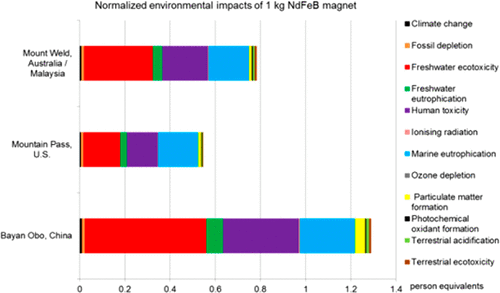当前位置:
X-MOL 学术
›
ACS Sustain. Chem. Eng.
›
论文详情
Our official English website, www.x-mol.net, welcomes your
feedback! (Note: you will need to create a separate account there.)
Comparative Life Cycle Assessment of NdFeB Permanent Magnet Production from Different Rare Earth Deposits
ACS Sustainable Chemistry & Engineering ( IF 7.1 ) Pub Date : 2018-03-22 00:00:00 , DOI: 10.1021/acssuschemeng.7b04165 Josefine Marx 1 , Andrea Schreiber 1 , Petra Zapp 1 , Frank Walachowicz 2
ACS Sustainable Chemistry & Engineering ( IF 7.1 ) Pub Date : 2018-03-22 00:00:00 , DOI: 10.1021/acssuschemeng.7b04165 Josefine Marx 1 , Andrea Schreiber 1 , Petra Zapp 1 , Frank Walachowicz 2
Affiliation

|
Neodymium, praseodymium, and dysprosium are rare earth elements often used in high performance magnets. Environmental impacts during the production of a 1 kg of neodymium iron boron (NdFeB) magnet from three major deposits are quantified using life cycle assessment (LCA). The scope of the assessment includes the largest rare earth oxide (REO) production in Bayan Obo (China), the second largest at a mine in Mount Weld (Australia), and a third mine in Mountain Pass (U.S.A.) that closed production in 2015. Consecutively, impacts from metal refining and final magnet production are added. Environmental impacts along the magnet production life cycle are dominated by the production of rare earth components (50–99.9%). Using REOs from the American mine shows the best overall environmental performance due to improved handling of chemicals. The biggest differences from the worst Chinese pathway can be found in freshwater and terrestrial ecotoxicity, acidification, freshwater eutrophication, particulate matter, and human toxicity. The smallest differences are observed for climate change, resource depletion, and marine eutrophication. For the first time, an LCA for the three largest rare earth producers was performed under the same frame of conditions and methodological assumptions. This approach is a step toward getting a consistent picture of environmental impacts.
更新日期:2018-03-22











































 京公网安备 11010802027423号
京公网安备 11010802027423号